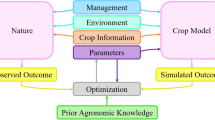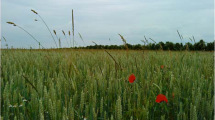Abstract
Crop models are tools used to analyze the interaction of crops and the environment. Since crop models can be applied to diverse research scales and purposes, models and their modifications vary. The parameters of a crop model could be biased for unseen data; thus, crop models should be calibrated for the adequate simulation of the given data. In this study, we aimed to calibrate food and feed crop models for sweet peppers (Capsicum annuum var. annuum) using Bayesian optimization. The algorithm does not require domain knowledge because it only considers input and output distributions based on Bayesian probability. For the implementation of Bayesian optimization, HyperOpt, an algorithm for optimizing high-dimensional hyperparameters, was used. The target growth factors were fruit yield and leaf area index, and the loss function was mean squared error (MSE). As a result, the calibrated crop model showed the highest modeling efficiency (EF) of 0.53, compared to − 1.91 and 0.62 from NLopt, a nonlinear optimization methodology, and random walk, respectively. The methodology showed adequate performance with reasonable ranges of convergence. The optimization method can be used for unknown distribution spaces of parameters because it does not require an initial status. Among the selected food crops, the groundnut model was suitable for sweet pepper. Since the optimized crop models yielded reasonable simulations, Bayesian optimization could be introduced for horticultural purposes. However, more data could be required to ensure convergence of the parameters and construct a robust crop model.







Similar content being viewed by others
Data availability
All data generated or analyzed during this study are included in this published article.
Abbreviations
- AMAXTB:
-
Maximum leaf CO2 assimilation rate as a function of development stage
- CVL:
-
Conversion efficiency of assimilates into leaves
- CVO:
-
Conversion efficiency of assimilates into storage organs
- DTSMTB:
-
Daily increase in temperature sum as function of average temperature
- DVS:
-
Developmental stage
- DVSI:
-
Initial development stage at the start of the simulation
- EFFTB:
-
Initial light-use efficiency of CO2 assimilation of single leaves as a function of mean daily temperature
- FLTB:
-
Fraction of above-ground dry matter increase partitioned to leaves as a function of the developmental stage
- FOTB:
-
Fraction of above-ground dry matter increase partitioned to storage organs as a function of the developmental stage
- FRTB:
-
Fraction of total dry matter increase partitioned to roots as a function of the developmental stage
- FSTB:
-
Fraction of above ground dry matter increase partitioned to stems as a function of developmental stage
- KDIFTB:
-
Extinction coefficient for diffuse visible light as a function of the developmental stage
- RFSETB:
-
Reduction factor for senescence as a function of the developmental stage
- RGRLAI:
-
Maximum relative increase in LAI
- SLATB:
-
Specific leaf area as a function of the developmental stage
- SPAN:
-
Lifespan of leaves growing at 35 °C
- SSATB:
-
Specific stem area as a function of the developmental stage
- TBASE:
-
Lower threshold temperature for the aging of leaves
- TBASEM:
-
Base temperature for the emergence
- TEFFMX:
-
Maximum effective temperature for the emergence
- TSUM1:
-
Temperature sum from the emergence to the anthesis
- TSUM2:
-
Temperature sum from the anthesis to the maturity
- TSUMEM:
-
Temperature sum from the sowing to the emergence
References
Asrar G, Fuchs M, Kanemasu ET, Hatfield JL (1984) Estimating absorbed photosynthetic radiation and leaf area index from spectral reflectance in wheat. Agron J 76:300–306. https://doi.org/10.2134/agronj1984.00021962007600020029x
Bergstra J, Bardenet R, Bengio Y, Kégl B (2011) Algorithms for hyper-parameter optimization. In: Shawe-Taylor J, Zemel R, Bartlett P, Pereira F, Weinberger KQ (eds) Advances in neural information processing systems, Curran Associates, Inc
Bergstra J, Komer B, Eliasmith C, Yamins D, Cox DD (2015) HyperOpt: a python library for model selection and hyperparameter optimization. Comput Sci Discov 8:014008. https://doi.org/10.1088/1749-4699/8/1/014008
Brisson N, Gary C, Justes E, Roche R, Mary B, Ripoche D, Zimmer D, Sierra J, Bertuzzi P, Burger P (2003) An overview of the crop model STICS. Eur J Agron 18:309–332
Ceglar A, van der Wijngaart R, de Wit A, Lecerf R, Boogaard H, Seguini L, van den Berg M, Toreti A, Zampieri M, Fumagalli D, Baruth B (2019) Improving WOFOST model to simulate winter wheat phenology in Europe: evaluation and effects on yield. Agric Syst 168:168–180. https://doi.org/10.1016/j.agsy.2018.05.002
Chaki AK, Gaydon DS, Dalal RC, Bellotti WD, Gathala MK, Hossain A, Menzies NW (2022) How we used APSIM to simulate conservation agriculture practices in the rice-wheat system of the Eastern Gangetic Plains. Field Crops Res 275:108344. https://doi.org/10.1016/j.fcr.2021.108344
De Corato U, De Bari I, Viola E, Pugliese M (2018) Assessing the main opportunities of integrated biorefining from agro-bioenergy co/by-products and agroindustrial residues into high-value added products associated to some emerging markets: a review. Renew Sust Energ Rev 88:326–346. https://doi.org/10.1016/j.rser.2018.02.041
de Wit A, Boogaard H, Fumagalli D, Janssen S, Knapen R, van Kraalingen D, Supit I, van der Wijngaart R, van Diepen K (2019) 25 years of the WOFOST cropping systems model. Agric Syst 168:154–167. https://doi.org/10.1016/j.agsy.2018.06.018
Del Amor FM (2006) Growth, photosynthesis and chlorophyll fluorescence of sweet pepper plants as affected by the cultivation method. Ann Appl Biol 148:133–139. https://doi.org/10.1111/j.1744-7348.2006.00048.x
Delfine S, Loreto F, Alvino A (2001) Drought-stress effects on physiology, growth and biomass production of rainfed and irrigated bell pepper plants in the mediterranean region. J Am Soc Hortic Sci 126:297–304
Frazier PI (2018) A tutorial on Bayesian optimization. arXiv preprint arXiv:1807.02811
Gijzen H, Heuvelink E, Challa H, Marcelis LFM, Dayan E, Cohen S, Fuchs M (1998) HORTISIM: a model for greenhouse crops and greenhouse climate. Acta Hortic. https://doi.org/10.17660/ActaHortic.1998.456.53
González-Real MM, Baille A, Liu HQ (2008) Influence of fruit load on dry matter and N-distribution in sweet pepper plants. Sci Hortic 117:307–315. https://doi.org/10.1016/j.scienta.2008.05.026
Gori M, Tesi A (1992) On the problem of local minima in backpropagation. IEEE Trans Pattern Anal Mach Intell 14:76–86. https://doi.org/10.1109/34.107014
Holzworth DP, Huth NI, deVoil PG, Zurcher EJ, Herrmann NI, McLean G, Chenu K, van Oosterom EJ, Snow V, Murphy C (2014) APSIM–evolution towards a new generation of agricultural systems simulation. Environ Model Softw 62:327–350
Jones JW, Hoogenboom G, Porter CH, Boote KJ, Batchelor WD, Hunt LA, Wilkens PW, Singh U, Gijsman AJ, Ritchie JT (2003) The DSSAT cropping system model. Eur J Agron 18:235–265. https://doi.org/10.1016/S1161-0301(02)00107-7
Jones JW, Antle JM, Basso B, Boote KJ, Conant RT, Foster I, Godfray HCJ, Herrero M, Howitt RE, Janssen S, Keating BA, Munoz-Carpena R, Porter CH, Rosenzweig C, Wheeler TR (2017) Brief history of agricultural systems modeling. Agric Syst 155:240–254. https://doi.org/10.1016/j.agsy.2016.05.014
Kumar H, Bhardwaj K, Sharma R, Nepovimova E, Kuča K, Dhanjal DS, Verma R, Bhardwaj P, Sharma S, Kumar D (2020) Fruit and vegetable peels: utilization of high value horticultural waste in novel industrial applications. Molecules 25:2812. https://doi.org/10.3390/molecules25122812
Lee J, Moon T, Nam DS, Park KS, Son JE (2018) Estimation of leaf area in paprika based on leaf length, leaf width, and node number using regression models and an artificial neural network. Hortic Sci Technol. https://doi.org/10.12972/kjhst.20180019
Lee JW, Kang WH, Moon T, Hwang I, Kim D, Son JE (2020) Estimating the leaf area index of bell peppers according to growth stage using ray-tracing simulation and a long short-term memory algorithm. Hortic Environ Biotechnol 61:255–265. https://doi.org/10.1007/s13580-019-00214-9
López-Marín J, González A, Pérez-Alfocea F, Egea-Gilabert C, Fernández JA (2013) Grafting is an efficient alternative to shading screens to alleviate thermal stress in greenhouse-grown sweet pepper. Sci Hortic 149:39–46. https://doi.org/10.1016/j.scienta.2012.02.034
Marcelis LFM, Heuvelink E, Goudriaan J (1998) Modelling biomass production and yield of horticultural crops: a review. Sci Hortic 74:83–111. https://doi.org/10.1016/S0304-4238(98)00083-1
Marcelis LFM, Heuvelink E, Baan Hofman-Eijer LR, Den Bakker J, Xue LB (2004) Flower and fruit abortion in sweet pepper in relation to source and sink strength. J Exp Bot 55:2261–2268. https://doi.org/10.1093/jxb/erh245
Marcelis LFM, Elings A, Bakker MJ, Brajeul E, Dieleman JA, Devisser PHB, Heuvelink E (2006) Modelling dry matter production and partitioning in sweet pepper. Acta Hortic. https://doi.org/10.17660/ActaHortic.2006.718.13
Muller B, Martre P (2019) Plant and crop simulation models: powerful tools to link physiology, genetics, and phenomics. J Exp Bot 70:2339–2344. https://doi.org/10.1093/jxb/erz175
Nash JE, Sutcliffe JV (1970) River flow forecasting through conceptual models part I—a discussion of principles. J Hydrol 10:282–290. https://doi.org/10.1016/0022-1694(70)90255-6
Rowan TH (1990) Functional stability analysis of numerical algorithms. PhD, The University of Texas at Austin
Sánchez-Molina JA, Pérez N, Rodríguez F, Guzmán JL, López JC (2015) Support system for decision making in the management of the greenhouse environmental based on growth model for sweet pepper. Agric Syst 139:144–152. https://doi.org/10.1016/j.agsy.2015.06.009
Steduto P, Hsiao TC, Raes D, Fereres E (2009) AquaCrop—the FAO crop model to simulate yield response to water: I. Concepts and underlying. Princ Agron J 101:426–437
Swallah MS, Sun H, Affoh R, Fu H, Yu H (2020) Antioxidant potential overviews of secondary metabolites (polyphenols) in fruits. Int J Food Sci 2020:e9081686
Van Diepen C et al (1989) WOFOST: a simulation model of crop production. Soil Use Manag 5:16–24
Xie Y, Wang P, Bai X, Khan J, Zhang S, Li L, Wang L (2017) Assimilation of the leaf area index and vegetation temperature condition index for winter wheat yield estimation using Landsat imagery and the CERES-Wheat model. Agric For Meteorol 246:194–206. https://doi.org/10.1016/j.agrformet.2017.06.015
Acknowledgements
This work was supported by the Korea Institute of Planning and Evaluation for Technology in Food, Agriculture and Forestry (IPET) and the Korea Smart Farm R&D Foundation (KosFarm) through the Smart Farm Innovation Technology Development Program, funded by the Ministry of Agriculture, Food and Rural Affairs (MAFRA), the Ministry of Science and ICT (MSIT), and the Rural Development Administration (RDA) (421001-03). Taewon Moon is grateful for financial support from the Hyundai Motor Chung Mong-Koo Foundation.
Author information
Authors and Affiliations
Contributions
Conceptualization, methodology, investigation, and writing—review and editing: TM and JES. Formal analysis and data curation: TM and SS. Supervision, project administration, and funding acquisition: JES. All authors have read and agreed to the published version of the manuscript.
Corresponding author
Ethics declarations
Conflict of interest
The authors declare that they have no conflicts of interest.
Additional information
Communicated by Yurina Kwack.
Publisher's Note
Springer Nature remains neutral with regard to jurisdictional claims in published maps and institutional affiliations.
Supplementary Information
Below is the link to the electronic supplementary material.
Rights and permissions
Springer Nature or its licensor (e.g. a society or other partner) holds exclusive rights to this article under a publishing agreement with the author(s) or other rightsholder(s); author self-archiving of the accepted manuscript version of this article is solely governed by the terms of such publishing agreement and applicable law.
About this article
Cite this article
Moon, T., Sim, S. & Son, J.E. Calibration of food and feed crop models for sweet peppers with Bayesian optimization. Hortic. Environ. Biotechnol. 64, 615–625 (2023). https://doi.org/10.1007/s13580-022-00510-x
Received:
Revised:
Accepted:
Published:
Issue Date:
DOI: https://doi.org/10.1007/s13580-022-00510-x




